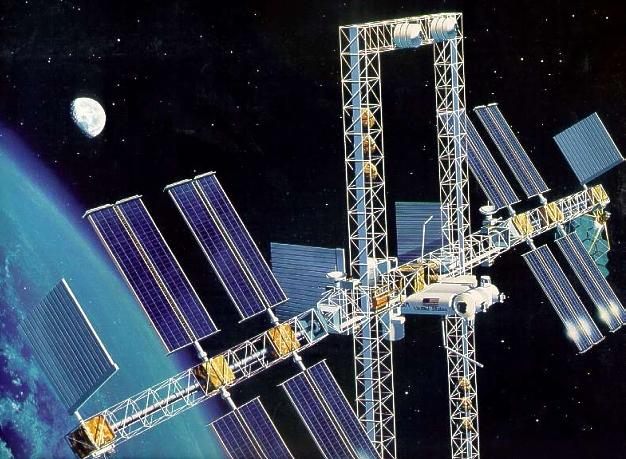China Plans To Build A Massive Solar Power Station In space – May Pass Scale Of Apollo Project And ISS.
China aims to construct a huge solar power station 36,000 kilometers above ground in an attempt to fight smog, cut greenhouse gases and solve energy crisis, very much based on the idea first floated by fiction writer Isaac Asimov in 1941. If this mega-project is realized, this will be the largest-ever space project surpassing the scale of Apollo project and that of the International Space Station.
The power station shall be a super spacecraft on a geosynchronous orbit with huge solar panels. The generated electricity shall be converted to microwaves or lasers and transmitted to a collector based in Earth, reported news agency Xinhua. In 1941, Asimov had published a short story ‘Reason’, in which he visualized a space station transmitting energy collected from the sun using microwave beams. Wang Xiji, an academician of the Chinese Academy of Sciences and an International Academy of Astronautics member, believes Asimov’s fiction has a strong scientific backing. Wang, 93, after having devoted over five decades to space technology research advocates the station stating that an an economically viable space power station would be really huge, with total solar panel area spanning 5 to 6 sq km. This would be equivalent to twelve of Beijing’s Tian’anmen Square, the largest public square in the world, or rather substitute that with two New York Central Park. You get the picture. Wang believes that the Earthlings may get to see it in the sky at night, like they do a star.
Wang states that the generated electricity from the ground-based solar plants fluctuates with day, night as well as the weather, but a space generator collects energy 99 percent of the time. Space-based solar panels thus can produce 10x electricity compared to ground-based panels per unit area, adds Duan Baoyan, a member of the Chinese Academy of Engineering. Duan hopes that with a space solar-power technology, the energy crisis on Earth could be solved.
Wang believes that whoever first acquires the technology can tap the future energy market, and thus this is of great significance. Countries like US and Japan have studied space solar power station, and Japan leads the development of wireless power transmission technology.
However, multiple hurdles lie in the way, like weight and cost. A commercially viable space power station would weigh 10,000 tons, but few rockets can carry a load of 100+ tonnes to low Earth orbit. Wang, who designed China’s first carrier rocket over four decades ago, states that they require a cheap heavy-lift launch vehicle. Also, they should aim to make very thin and light solar panels, such that the panel weighs less than 200 grams per square meter.
4 Comments
Leave a Reply
Cancel reply
-
Advertisement
Copyright © 2020 Indian Nerve. All Rights Reserved.


Fujin
April 2, 2015 at 11:06 am
yayyy..njan aane aadyam comment cheythe!
Andrew
April 3, 2015 at 8:26 am
Launching on a SpaceX Falcon Heavy would cost $38 billion USD, about 2.5 trillion rupees. I’m more familiar with the USD, so will use that for the calculations. All calculations are based on this project being launched in five years. As time increases, power would go up, and cost would go down.
Typical satellite cost is about %50 launch, so I assume overall cost is $76B.
About 30% of the sun’s energy is lost before it hits the ground, so will assume that solar panels in space can achieve 1300 Watts/square meter.
6km of solar panels means a production of 46,800 Megawatts. That’s about 15% of the energy currently supplied by nuclear reactors. An average nuclear reactor supplies 1000 MW and costs $5B. The solar panels would be equivalent to 47 nuclear reactors which would cost $235B. The solar panels seem cost effective to me.
**There are lifetime costs associated with each system. This is a super barebones estimate of capital costs.
Andrew
April 3, 2015 at 8:30 am
Messed up the calculation so that the power supplied by the solar panels is 6x actual.
Correct numbers:
6km of solar panels means a production of 7,800 Megawatts. That’s about 2.5% of the energy currently supplied by nuclear reactors. An average nuclear reactor supplies 1000 MW and costs $5B. The solar panels would be equivalent to 8 nuclear reactors which would cost $40B. The solar panels seem cost inefficient compared to nuclear reactors. However, if this is done ten years from now, launch and manufacture prices could be up to half what I estimated for five years from now. This would bring the cost in line with nuclear reactors.
Bob Ronnenkamp
April 4, 2015 at 9:03 pm
3D printers already in space, capturing some space rocks for raw material, solar panels manufactured in space don’t have to support their own weight. Costs will drop as project goes on as heavy lifting will be minimized. Peter Diamandis blog and the book Bold great resources.